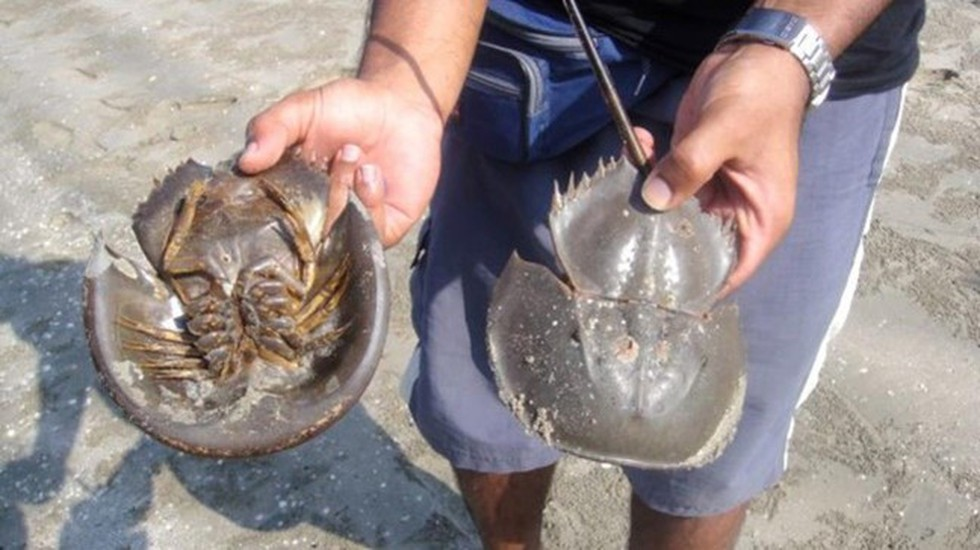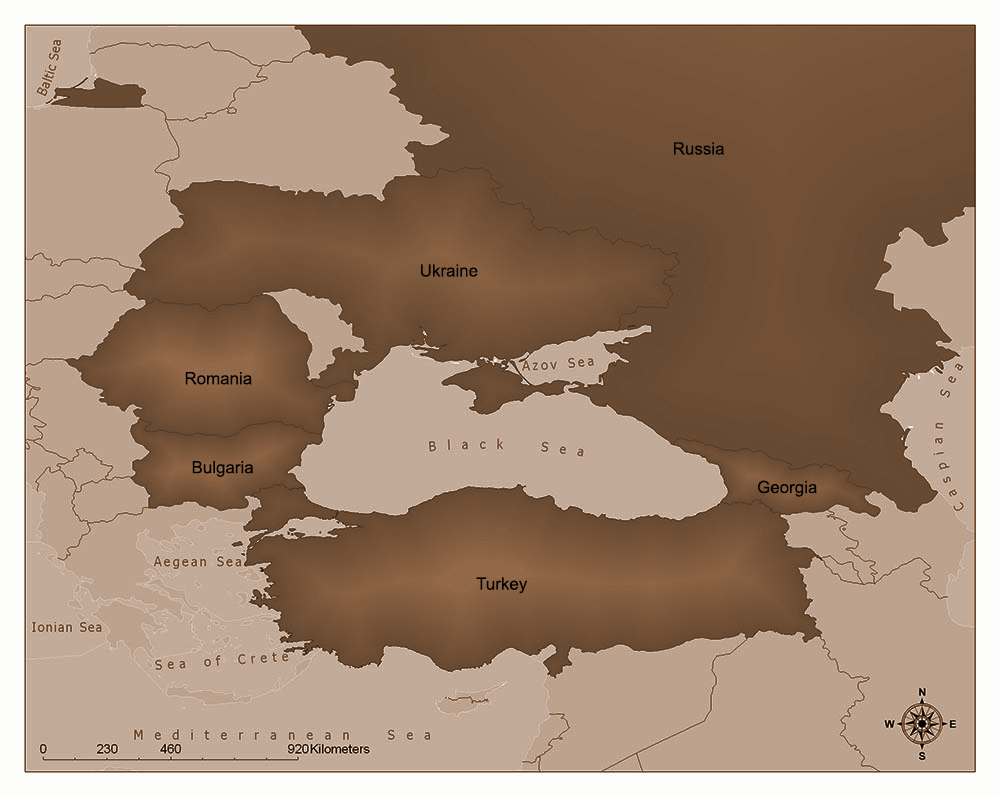Table of Contents
Horseshoe Crab
Context: Environmental organisations petitioned the U.S. government to classify the American horseshoe crab as an endangered species. These are under threat from commercial harvests for bait and biomedical use as well as from habitat loss and climate change.
Horseshoe Crabs Overview
- Habitat: Inhabit shallow coastal waters with soft sandy or muddy bottoms; spawn on intertidal beaches during summer-spring high tides.
- Classification: Belong to the Chelicerata group within Arthropoda, which includes spiders and scorpions.
- Characteristics: Segmented bodies, limbs, and a thick chitinous exoskeleton.
- Status: Known as marine ‘living fossils’.

- Species:
- American Horseshoe Crab (Limulus polyphemus): Found along the eastern coast of the USA and Gulf of Mexico.
- Tri-Spine Horseshoe Crab (Tachypleus tridentatus).
- Coastal Horseshoe Crab (Tachypleus gigas).
- Mangrove Horseshoe Crab (Carcinoscorpius rotundicauda): These last three species are predominantly in Indo-Pacific regions, including coastal India, Southeast Asia, China, and Japan.
- Indian Habitat: Odisha is the primary habitat in India.
- Conservation Status:
- In India: Protected under Schedule IV of the Wildlife Protection Act, 1972.
- IUCN: American horseshoe crab is ‘Vulnerable’, Tri-spine horseshoe crab is ‘Endangered’, other two species not yet listed.
We’re now on WhatsApp. Click to Join
WPI
Context: Wholesale price index (WPI) inflation fell to 0.27%, a three-month low, with a decrease from 4.8% a year earlier and 0.73% in the previous month.
What is the Wholesale Price Index (WPI)?
- The Wholesale Price Index (WPI) is a price index that measures the average change in wholesale prices of a basket of goods.
- It is an important measure of inflation, as it tracks the prices of goods before they reach consumers.
- The WPI is calculated by the Office of Economic Adviser (OEA) in the Ministry of Commerce and Industry.
- The WPI is typically released every month.
- The WPI is determined by monitoring the prices of a selected basket of goods and services that represent the economy, comparing them to a base year, and calculating the percentage change, typically expressed as a percentage change from the base year.
- The base year of All-India WPI has been revised from 2004-05 to 2011-12 in 2017.
| Major Groups | Weightage | Articles |
| Primary Articles | 22.6% |
|
| Fuel & Power | 13.2% | LPG, Petrol, High-Speed Diesel |
| Manufactured Products | 64.2% | Manufacture of Food Products: Vegetable And Animal Oils and Fats
Manufacture of Beverages, Manufacture of Tobacco Products, Wearing Apparel, Pharmaceuticals, Medicinal Chemical and Botanical Products, and other Non-Metallic Mineral Products etc. |
Black Sea – Bordering Countries
Context: Ukraine destroyed two Russian warships in the Black sea.
Bordering Countries
- The Black Sea is a large inland sea situated at the southeastern extremity of Europe. It is one of the most famous inland seas in the world and is bordered by Ukraine, Russia, Georgia, Turkey, Bulgaria and Romania.

Note: You can remember this through a trick-T-BURGeR (Turkey- Bulgaria, Ukraine, Romania, Georgia and Russia).
China’s Defence Villages
Context: Chinese nationals have started occupying several of their model “Xiaokang” border defence villages across India’s north-eastern borders which the country has been building along the Line of Actual Control (LAC) since 2019.
About Defence Villages
- “Defence villages” are typically strategically located settlements constructed near a country’s borders, often with the dual purpose of asserting territorial claims and supporting military operations.
- These villages can serve logistical needs, accommodate troops, and strengthen border security.
- The nature of such villages can vary, but they are generally part of a broader strategy of frontier governance and control.
| China’s Defence Villages |
|
Rajya Sabha Elections
Context: The Rajya Sabha elections for 56 vacant seats will be conducted on February 27.
About Rajya Sabha
- Present Strength: 245 members (233 elected, 12 nominated)
- Maximum Strength: 250 (as per Constitution)
- Composition:
- 233 elected from states and UTs
- 12 nominated by President for expertise in art, literature, science, social services
- Tenure: 6 years, with elections for 1/3 members every 2 years
- Vacancy: Filled for remaining term of predecessor
- Chairperson: Vice President of India (ex-officio), with Deputy Chairman appointed from members.
- Nature Of House: Permanent (i.e. cannot be dissolved)
- Prorogued?: Yes, by the president.
Procedure Of Election
- Electorate:
- Indirect: Elected by MLAs (Members of Legislative Assembly)
- Size varies per state based on population.
- Voting System: Proportional Representation with Single Transferable Vote (STV)
- MLAs rank candidates in order of preference (1, 2, 3…) on a single ballot.
- Each vote counted only once.
- Open ballot with verification to prevent cross-voting.
- Winning Quota:
- Formula for single seat: Total votes / (Number of seats + 1) + 1
- Formula for multiple seats: [(Number of votes x 100) / (Vacancies + 1)] + 1
- Quota decreases with more seats or vacancies.
In 2003, the Representation of People (Amendment) Act introduced two significant changes to the Rajya Sabha elections:
|
|
Articles Related To The Election Of Rajya Sabha |
|
| Article 80(3) | The President nominates 12 members based on expertise in literature, science, art, or social service. |
| Article 80(4) | State representatives elected by state legislators using proportional representation by the means of Single Transferable Vote. |
| Article 83(1) | No dissolution; one-third retire every 2 years following a parliamentary law. |
Difference Between Lok Sabha and Rajya Sabha Elections
| Aspect | Rajya Sabha Elections | Lok Sabha Elections |
| Electoral Body | Elected by the elected members of State Legislative Assemblies (MLAs). | Directly elected by the eligible voters of India. |
| Voting System | Proportional representation by means of a single transferable vote (STV). | First-past-the-post system (simple majority). |
| Eligibility of Voters | Only MLAs are eligible to vote. | All Indian citizens aged 18 and above, registered as voters, are eligible to vote. |
| Constituency | No specific constituency; MLAs from each state vote for candidates. | Each MP represents a specific geographical constituency. |
| Nominated Members | 12 members are nominated by the President for their contributions in art, literature, science, etc. | No members are nominated; all are elected. |
| Term Duration | Each member serves for six years, with one-third of members retiring every two years. | Members are elected for a term of five years, unless the House is dissolved earlier. |
| House Permanence | Rajya Sabha is a permanent house and cannot be dissolved. | Lok Sabha can be dissolved and fresh elections are held usually every five years. |
| Minimum Age | To be an MP (Member of Parliament) of the Lok Sabha, one has to be at least 25 years of age. | To be an MP (Member of Parliament) of the Rajya Sabha, one has to be at least 30 years of age. |
INSAT 3DS
Context: The Indian Institute of Research Organisation (ISRO) will launch INSAT-3DS from Sriharikota.
About INSAT-3DS
- Purpose: Improve weather forecasting in India.
- Successor to: INSAT-3DR.
- Funded by: Ministry of Earth Sciences
- Goals:
- Track extreme weather events (cyclones, thunderstorms, etc.).
- Enhance observation of atmosphere and ocean parameters.
- Payloads:
- An Imager: for capturing detailed visual information.
- A Sounder: to collect data on atmospheric temperature and humidity profiles.
- A Data Relay Transponder: for facilitating communication.
- A Satellite Aided Search and Rescue Transponder: to assist in rescue operations
- Benefits:
- Improved forecasting accuracy.
- Better understanding and prediction of severe weather patterns.
- Potential reduction in life and property loss from natural disasters.
- Launch: Sriharikota, India.
- Part of: ISRO’s Earth observation efforts.


 Indus Water Treaty 1960 Suspended by Ind...
Indus Water Treaty 1960 Suspended by Ind...
 5 Years of SVAMITVA Scheme and Its Benef...
5 Years of SVAMITVA Scheme and Its Benef...
 Places in News for UPSC 2025 for Prelims...
Places in News for UPSC 2025 for Prelims...





















